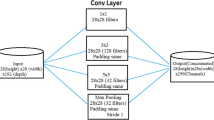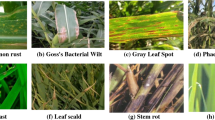Abstract
Purpose
Plant diseases are one of the main factors affecting food production and reducing production losses, they must be swiftly identified and treated. Deep learning algorithms in association with computer vision techniques have recently found usage in the diagnosis of plant diseases, offering a potent tool with highly accurate results. The objective of this study is to identify a stacking ensemble-based solution by using several algorithms in the process of classifying and diagnosing plant diseases, describing trends, and emphasizing gaps.
Method
The stacking ensemble is made using top four performing deep learning algorithms and multi-layered perceptron as meta classifier. In this regard, we reviewed more than 15 studies from the previous three years that address problems with disease detection, dataset characteristics, researched crops, and pathogens in various ways.
Results
The proposed ensemble model achieved a maximum accuracy of 98.13% compared to the conventional architectures. For comparing the results, various performance metrics are used such as accuracy, loss, precision etc. which outperformed the results of the deep learning algorithms run separately for the data as shown in Table 5.
Conclusion
The suggested framework can help identify the presence of disease in a sample of plant leaves as a preventative strategy as the results were quite promising compared to the results of existing literature.


















Similar content being viewed by others
Data availability
The datasets used and/or analyzed during the current study are available from the corresponding author on reasonable request.
References
Ahmad A, El Gamal A, Saraswat D (2023) Toward generalization of deep learning-based plant disease identification under controlled and field conditions. IEEE Access 11:9042–9057
Anim-Ayeko AO, Schillaci C, Lipani A (2023) Automatic blight disease detection in potato (Solanum tuberosum L) and tomato (Solanum lycopersicum, L 1753) plants using deep learning. Smart Agric Technol 4:100178
Ballard D, Lecun Y, Boser B, Denker JS, Henderson D, Howard RE, Hubbard W, Jackel LD (1989) Backpropagation Applied to Handwritten Zip Code Recognition. Neural Comput 4:541–51
Bi C, Wang J, Duan Y, Fu B, Kang JR, Shi Y (2022) MobileNet Based Apple Leaf Diseases Identification. Mob Netw Appl 27(1):172–180. https://doi.org/10.1007/s11036-020-01640-1
Chollet, F. (2016). Xception: Deep Learning with Depthwise Separable Convolutions. http://arxiv.org/abs/1610.02357
Chug A, Bhatia A, Singh AP, Singh D (2023) A novel framework for image-based plant disease detection using hybrid deep learning approach. Soft Comput 27(18):13613–13638
Emmanuel, “PlantVillage Dataset” (2018). Distributed by Kaggle. https://www.kaggle.com/datasets/emmarex/plantdisease
Fenu G, Malloci FM (2021) Using Multioutput Learning to Diagnose Plant Disease and Stress Severity. Complexity 2021:6663442. https://doi.org/10.1155/2021/6663442
He K, Zhang X, Ren S, & Sun J (2015). Deep Residual Learning for Image Recognition. http://arxiv.org/abs/1512.03385
Howard AG, Zhu M, Chen B, Kalenichenko D, Wang W, Weyand T, Andreetto M, & Adam H (2017). MobileNets: Efficient Convolutional Neural Networks for Mobile Vision Applications. http://arxiv.org/abs/1704.04861
Huang G, Liu Z, van der Maaten L, & Weinberger KQ (2016). Densely Connected Convolutional Networks. http://arxiv.org/abs/1608.06993
Ian H. W., Eibe F. and Mark A. H., “Data Mining: practical machine learning tools and techniques” 3rd ed., Morgan Kaufmann, 2011
Islam MA, Rahman Shuvo N, Shamsojjaman M, Hasan S, Hossain S, Khatun T (2021) An Automated Convolutional Neural Network Based Approach for Paddy Leaf Disease Detection. Int J Adv Comput Sci Appl 12(1):280–288
Jadhav SB, Udupi VR, Patil SB (2021) Identification of plant diseases using convolutional neural networks. Int J Inf Technol 13(6):2461–2470. https://doi.org/10.1007/s41870-020-00437-5
Jayakumar D, Elakkiya A, Rajmohan R, & Ramkumar MO (2020, July 3). Automatic Prediction and Classification of Diseases in Melons using Stacked RNN based Deep Learning Model. 2020 International Conference on System, Computation, Automation and Networking, ICSCAN 2020. https://doi.org/10.1109/ICSCAN49426.2020.9262414
Krizhevsky A, Sutskever I & Hinton GE (2012). ImageNet Classification with Deep Convolutional Neural Networks. http://code.google.com/p/cuda-convnet/
Lu Y, Yi S, Zeng N, Liu Y, Zhang Y (2017) Identification of rice diseases using deep convolutional neural networks. Neurocomputing 267:378–384. https://doi.org/10.1016/j.neucom.2017.06.02
Mohanty SP, Hughes DP, Salathé M (2016) Using deep learning for image-based plant disease detection. Front Plant Sci 7. https://doi.org/10.3389/fpls.2016.01419
Moupojou E, Tagne A, Retraint F, Tadonkemwa A, Wilfried D, Tapamo H, Nkenlifack M (2023) FieldPlant: A dataset of field plant images for plant disease detection and classification with deep learning. IEEE Access 11:35398–35410
Opitz, D., & Maclin, R. (1999). Popular Ensemble Methods: An Empirical Study. In Journal of Artificial Intelligence Research (Vol. 11)
Patil RR, Kumar S, Rani R (2022) Comparison of Artificial Intelligence Algorithms in Plant Disease Prediction. Revue d’Intelligence Artificielle 36(2):185–193. https://doi.org/10.18280/ria.360202
Picon A, Alvarez-Gila A, Seitz M, Ortiz-Barredo A, Echazarra J, Johannes A (2019) Deep convolutional neural networks for mobile capture device-based crop disease classification in the wild. Comput Electron Agric 161:280–290. https://doi.org/10.1016/j.compag.2018.04.002
Rangarajan AK, Purushothaman R, Ramesh A (2018) Tomato crop disease classification using pre-trained deep learning algorithm. Procedia Comput Sci 133:1040–1047. https://doi.org/10.1016/j.procs.2018.07.070
Shrestha G, Deepsikha Das M, & Dey N (2020). Plant Disease Detection Using CNN. Proceedings of 2020 IEEE Applied Signal Processing Conference, ASPCON 2020, 109–113. https://doi.org/10.1109/ASPCON49795.2020.9276722
Simonyan, K., & Zisserman, A. (2014). Very Deep Convolutional Networks for Large-Scale Image Recognition. http://arxiv.org/abs/1409.1556
spMohanty, “PlantVillage Dataset” (2016). Distributed by Github. https://github.com/spMohanty/PlantVillage-Dataset
Sujatha R, Chatterjee JM, Jhanjhi NZ, Brohi SN (2021) Performance of deep learning vs machine learning in plant leaf disease detection. Microprocess Microsyst 80:103615. https://doi.org/10.1016/j.micpro.2020.103615
Szegedy C, Vanhoucke V, Ioffe S, & Shlens J (2015). Rethinking the Inception Architecture for Computer Vision
Too EC, Yujian L, Njuki S, Yingchun L (2019) A comparative study of fine-tuning deep learning models for plant disease identification. Comput Electron Agric 161:272–279. https://doi.org/10.1016/j.compag.2018.03.032
Turkoglu M, Hanbay D, Sengur A (2022) Multi-model LSTM-based convolutional neural networks for detection of apple diseases and pests. J Ambient Intell Humaniz Comput 13(7):3335–3345. https://doi.org/10.1007/s12652-019-01591-w
Wagle SA, Harikrishnan R (2021) Comparison of plant leaf classification using modified alexnet and support vector machine. Traitement Du Signal 38(1):79–87. https://doi.org/10.18280/TS.380108
Waheed A, Goyal M, Gupta D, Khanna A, Hassanien AE, Pandey HM (2020) An optimized dense convolutional neural network model for disease recognition and classification in corn leaf. Comput Electron Agric 175:105456. https://doi.org/10.1016/j.compag.2020.105456
Acknowledgements
NA.
Funding
NA.
Author information
Authors and Affiliations
Contributions
AS: Conceptualization, validation, writing- original, Conceptualization, carrying out the work RD: Conceptualization, carrying out the work, writing reviewing, data analysis, investigation, data curation, and editing ARS: Conceptualization, carrying out the work, writing-reviewing, and editing.
Corresponding author
Ethics declarations
Conflict of interest
The authors have no relevant financial or nonfinancial interests to disclose. The author has declared no conflict of interest.
Additional information
Responsible Editor: Stephane Compant.
Publisher's Note
Springer Nature remains neutral with regard to jurisdictional claims in published maps and institutional affiliations.
Rights and permissions
Springer Nature or its licensor (e.g. a society or other partner) holds exclusive rights to this article under a publishing agreement with the author(s) or other rightsholder(s); author self-archiving of the accepted manuscript version of this article is solely governed by the terms of such publishing agreement and applicable law.
About this article
Cite this article
Sharma, A., Dalmia, R., Saxena, A. et al. A stacked deep learning approach for multiclass classification of plant diseases. Plant Soil (2024). https://doi.org/10.1007/s11104-024-06719-2
Received:
Accepted:
Published:
DOI: https://doi.org/10.1007/s11104-024-06719-2




